Discover 11 hidden attractions, cool sights, and unusual things to do in Radebeul (Germany). Don't miss out on these must-see attractions: Schloss Wackerbarth, Altkötzschenbroda, and Vinothek Hoflößnitz. Also, be sure to include Karl-May-Museum in your itinerary.
Below, you can find the list of the most amazing places you should visit in Radebeul (Saxony).
Table of Contents
Schloss Wackerbarth
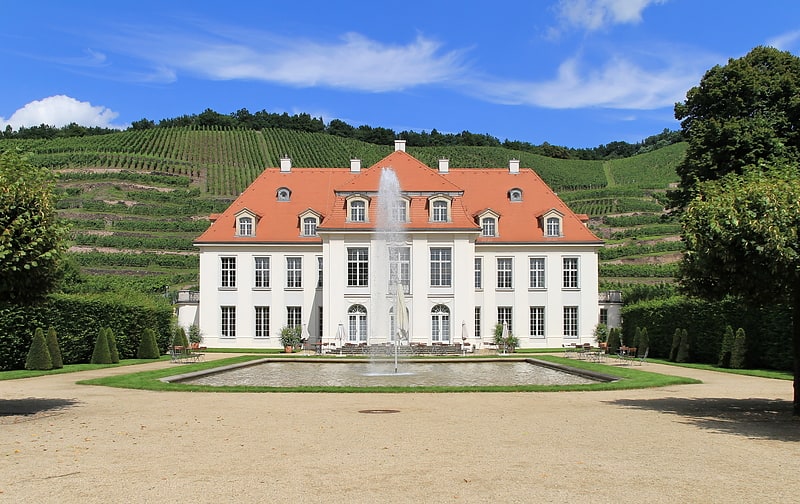
Wackerbarth Castle, originally Wackerbarths Ruh', is a Baroque castle surrounded by vineyards in the Niederlößnitz district of Radebeul on the road to Meissen, which serves as the headquarters of the Saxon State Winery. The winery belongs to the single vineyard Radebeuler Johannisberg within the large vineyard Lößnitz and is located in the protected historic vineyard landscape Radebeul. The historic area of the castle forms an offshoot of the Lößnitz landscape conservation area above it. Schloss Wackerbarth as a Saxon cultural heritage is a member of the marketing association Schlösserland Sachsen, the GmbH a subsidiary of the Sächsische Aufbaubank.
Since its establishment as the retirement residence of Field Marshal General and Imperial Count August Christoph von Wackerbarth and until the founding of Niederlößnitz in 1839, the estate was a manor directly subordinate to the Dresden office on the Naundorf vineyard.
Today, the Saxon State Winery Schloss Wackerbarth, consisting of the historic complex and the modern new building of the wine and sparkling wine manufactory, is open to the public for viewing. The in-house products are tasted and sold, the associated glass production can be visited. In the open spaces surrounding the buildings, sample vines of the cultivated grape varieties can also be seen in their seasonal growth. The estate's own restaurant is housed in the eastern, listed farm building. The higher Belvedere also serves as a venue for wedding ceremonies.
Address: Wackerbarthstraße 1, 01445 Radebeul
Altkötzschenbroda
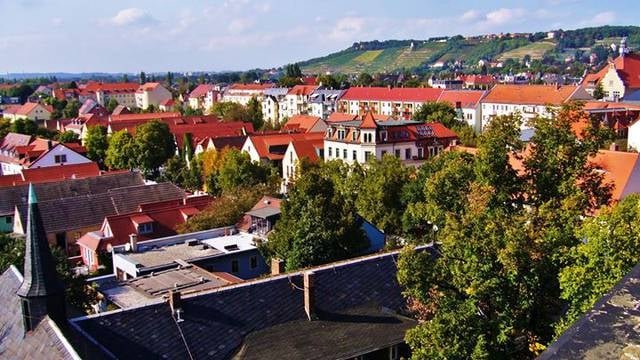
Top attraction, Square
Vinothek Hoflößnitz

The Hoflößnitz Mountain and Pleasure House in Radebeul-Oberlößnitz is the main building of the former electoral or royal Saxon, now municipal Hoflößnitz Winery.
The winery is located on the former country estate of the Wettin dynasty in the countryside of Lößnitz and was the center of the Saxon court vineyard estate for almost 500 years. The vineyard castle, also romantically called Schloss Hoflößnitz since historicism, was the manor house of the Saxon ruler when he stayed at the courtly Hoflößnitz vineyard estate, built from 1648 to 1650 as the first significant building project immediately after the Thirty Years' War. Elector Johann Georg I had it kept simple on the outside, while the inside hides a completely different kind of splendor: "Tropical peacocks, screaming red cockatoos, Brazilian parrots adorn the banqueting hall on the ceiling; there are eighty panel paintings in all, colorful and true to life - right down to the last tail tip."
The Berg- und Lusthaus is today the main building of the Saxon Wine Museum Hoflößnitz. The first floor presents the history of Saxon viticulture, while the upper floor, with the banqueting hall and the two living rooms and bedrooms of the Elector and Electress, is considered "one of the most remarkable examples of 17th century decoration".
The Hoflößnitz with its Berg- und Lusthaus, Presshaus, Kavalierhaus and wine press is listed as a "monument-preserving entity" (ensemble protection). The entire open and green space, including the surrounding vineyard landscape with the Goldener Wagen vineyard, is considered a work of "landscape and garden design" within the Historic Radebeul Vineyard Landscape monument protection area. The Hoflößnitz also includes the vintner's house with attached bakehouse located below and to the right of the entrance and gateway, respectively, as well as the former wooden courtyard to the left facing the ground, also with a vintner's house.
Address: Knohllweg 37, 01445 Radebeul
Karl-May-Museum
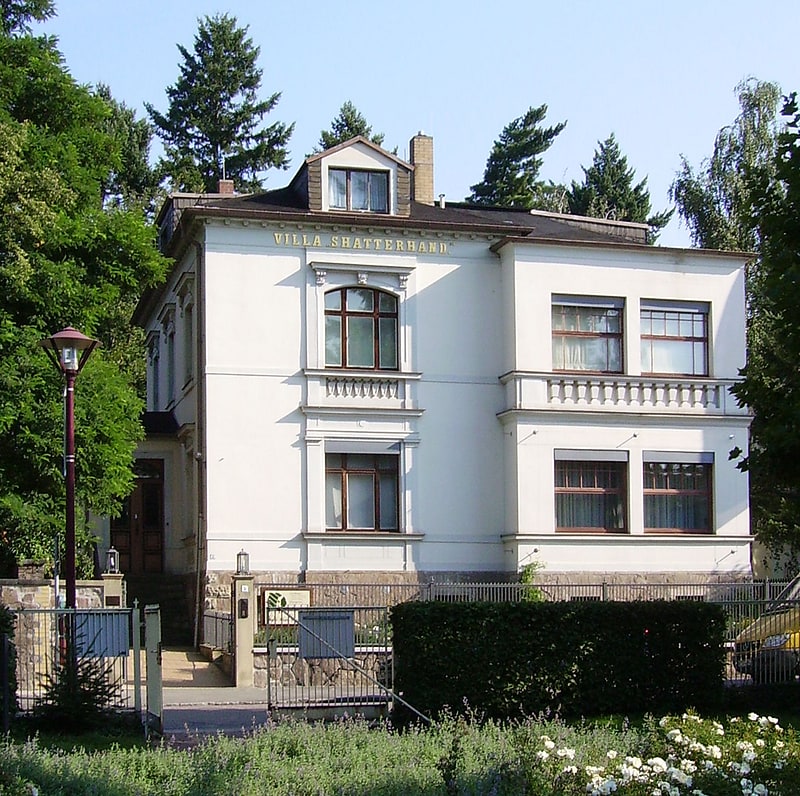
Museum in Radebeul, Germany. The Karl May Museum is a museum in Radebeul, Germany named after the German author Karl May, containing artifacts from May's life as well as from life on the American frontier and Native American life of that era. It is located in Villa Shatterhand, May's Italian Renaissance home.[1]
Address: Karl-May-Straße 5, 01445 Radebeul
Heimatstube Kötzschenbroda

Museum
Address: 21 Altkötzschenbroda, Radebeul
Brunnenskulptur „…gegen den Strom…“
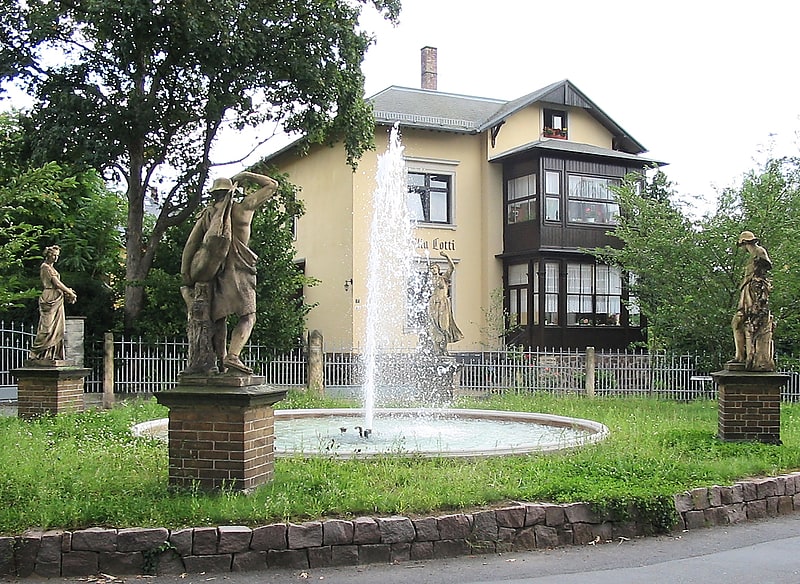
The list of fountains and water features in Radebeul gives an overview of fountains and water features in the Saxon city of Radebeul. Some of the installations are now listed as small architecture.
While many of the (half-)farmsteads in the village locations of the Lößnitz villages had their own wells, there were community-owned wells in the village centers, especially for the cottagers, of which the well rediscovered and restored in 1996 on the Anger Altnaundorf bears witness. Whether this also applied to the village center of Serkowitz would have to be clarified, since there the Lößnitzbach stream flowed directly over the Anger on its way to the Elbe. A sinking groundwater level and the increased water consumption in the 18th and 19th centuries associated with the growth of the population ensured that the application for a building permit for a villa was often accompanied by an application and approval for the sinking or drilling of a well. Many of these deep wells, which were then filled in or covered after the construction of the tap water supply in the 1920s, were rediscovered after the fall of the Wall and are now used in part for garden irrigation using service water.
The Radebeul wineries, most of which were located below the Lößnitz plateau, had their own water supply. Where dug wells were no longer appropriate because of the great depth to the aquifer, run-of-river wells with enclosed slope springs were used because of the mountainous location. In the higher-lying terrain, springs were captured and their water was then conducted via ditches and through breakthroughs through slope edges to well houses located in the courtyard of the estates. Since the 17th century, tubing has also been used in some cases, the best-known of which was the wooden Straken water pipe to Hoflößnitz, which was put into operation in 1625 and initially had twelve water-fee riparians. Pipe lines also led to the Minckwitz vineyard, since about 1770 from Stephansborn to Wackerbarths Ruh' and since about 1820 from Schwarzes Teich to the courtyard of Altfriedstein (Roos'sche Wasserleitung).
With the development of today's villa quarters of the Loessnitz also came the desire for simpler water supply as well as for water as an ornamental element. In 1867/68, the Ziller brothers built a first iron fall water pipeline from the elevated Wahnsdorf. But it was not until they built the Ziller waterworks in the first half of the 1870s that they were able to connect the new housing quarters with pressurized water pipes. Thus, in order to make the villas more attractive to the clientele, numerous properties with ornamental fountains were built, some of which still exist today. Several of these are also listed as part of the listed estates themselves; these are listed in the subchapter Listed ornamental fountains and water features in private spaces. But the Ziller brothers in particular did not stop at the private property line. Public fountain installations were not only intended to beautify residential neighborhoods, but also to knock down dust from the only partially paved streets and sidewalks via air humidification. Of the such installations on the Zillerplatz, the two Königplätzen in Oberlößnitz and Niederlößnitz as well as on the traffic circle of the then Albertstraße (after the king of his time), only the latter remained, which today bubbles up again as the Fontainenplatz.
After reunification, a number of ornamental fountains and water features were newly created in Radebeul in addition to the historic water features in publicly accessible spaces.
Church of Peace
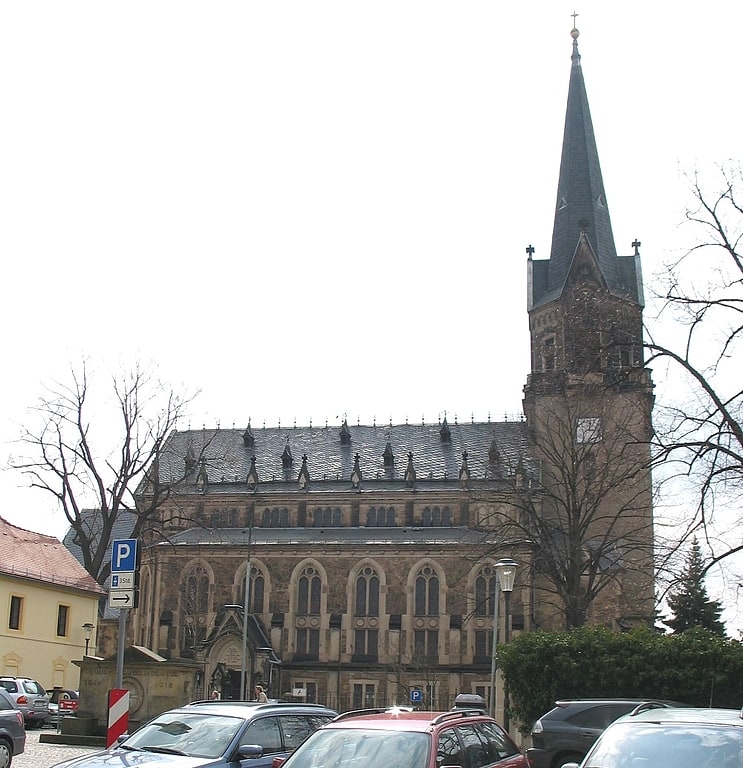
Friedenskirche zu Radebeul, formerly Kirche zu Kötzschenbroda, is an Evangelical Lutheran church on the Anger of Altkötzschenbroda in Radebeul-West, Saxony. On August 27, 1645, the Armistice of Kötzschenbroda was concluded between the Saxon Elector Johann Georg I and the Swedish General Lennart Torstensson under the host Pastor Augustin Prescher in the associated rectory, which ended the Thirty Years' War for Saxony. In 2012, the Saxon State Center for Political Education honored the church together with the Karl Preusker Library in Großenhain as Political Places in Saxony.
Address: Altkötzschenbroda 40, 01445 Radebeul
Landesbühnen Sachsen
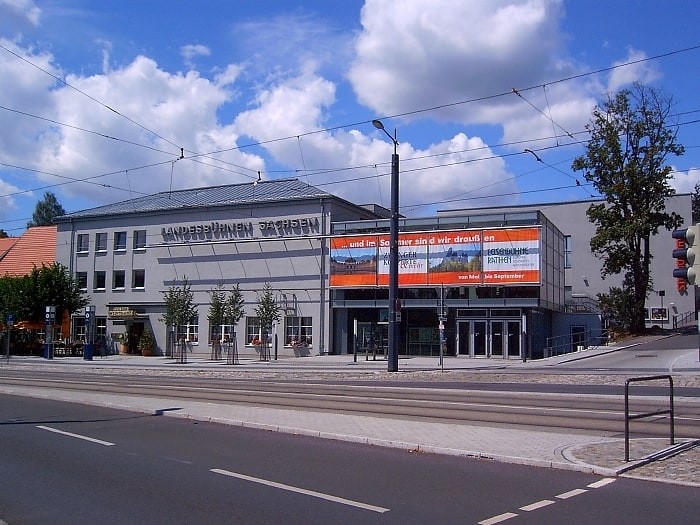
Landesbühnen Sachsen GmbH is Germany's second largest touring theater with its headquarters in Radebeul near Dresden. Its artistic director since October 1, 2011 is Manuel Schöbel, opera director since 2017 is Sebastian Ritschel, the head of drama is Peter Kube. In 2015, 186,000 guests attended the 600 performances at the main house in Radebeul and at guest performances in Saxony. This represented an increase of 12,000 visitors compared to 2014.
The parent company is located in the premises of the former Goldene Weintraube inn, at 152 Meißner Street.
Address: Meißner Str. 152, 01445 Radebeul
Bismarckturm Radebeul

View point, Tower
Address: Spitzhaus straße, Radebeul
Kirche Christus König
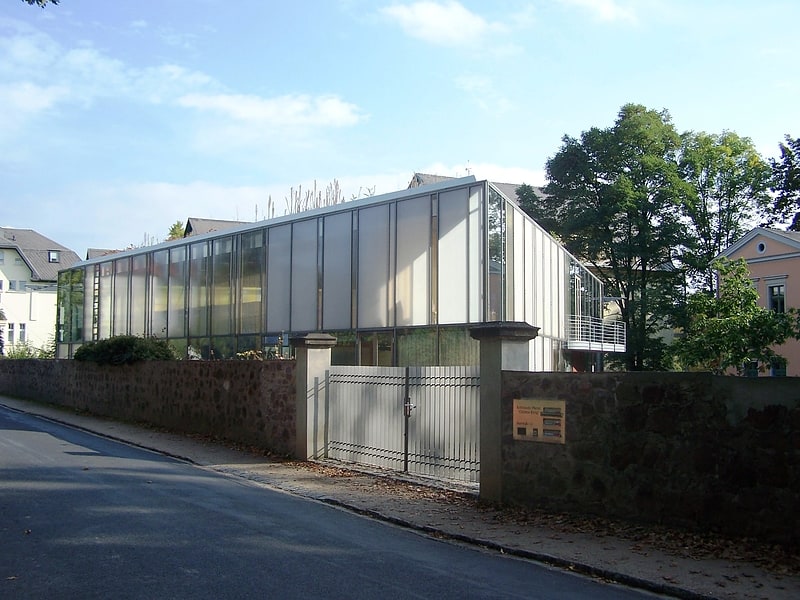
Christus König Church stands at 11 Borstrasse in the Niederlößnitz district of the Saxon city of Radebeul. The Catholic church is an unusual building over an equilateral triangular floor plan and with glass walls. Designed by architects Günter Behnisch and Gerald Staib, the house of worship was consecrated on November 25, 2001.
Friedensburg

The Friedensburg in the Saxon town of Radebeul is a former mountain inn used as a residential building on the edge of the slope above Niederlößnitz, at Obere Burgstraße 6. Below it is the municipal steep-slope vineyard of the same name, Friedensburg, which is part of the Radebeuler Steinrücken vineyard. The silhouette of the Niederlößnitz vineyards is significantly shaped by the Friedensburg, together with the water tower standing slightly to the west. The Friedensburg is located in the Historic Vineyard Landscape Radebeul monument protection area.
Address: 6 Obere Burgstraße, Radebeul